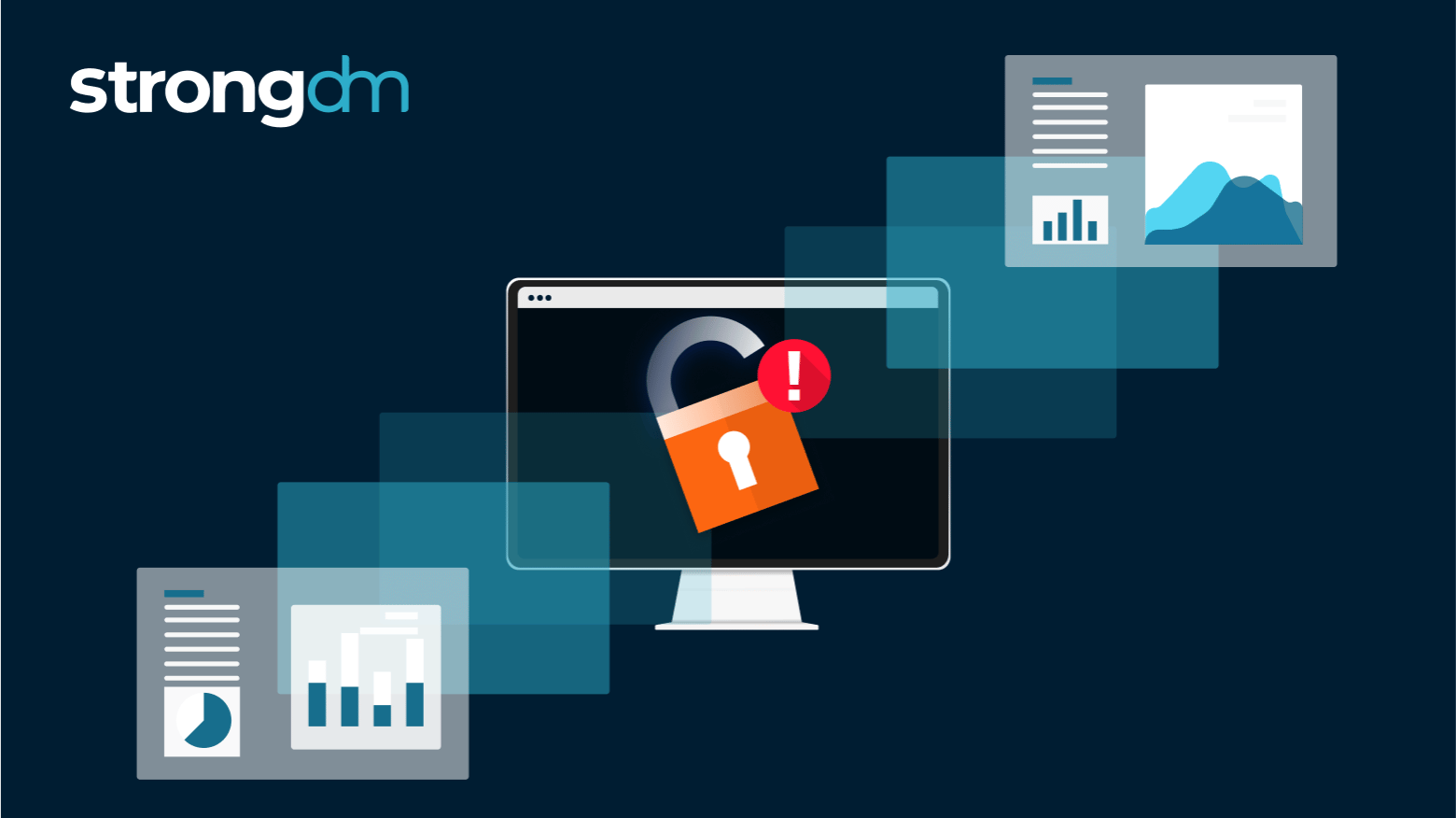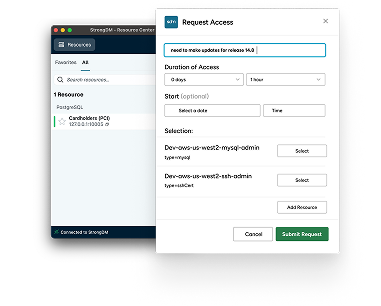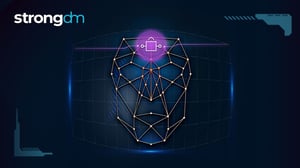

Written by
StrongDM Team
Reviewed by
John MartinezLast updated on:
June 27, 2025Reading time:
Contents
Built for Security. Loved by Devs.
- Free Trial — No Credit Card Needed
- Full Access to All Features
- Trusted by the Fortune 100, early startups, and everyone in between
A breach isn’t a matter of if, it’s when. In 2023 alone, around 97 million accounts were breached in the US, accounting for one in three cases worldwide. Whether it’s a rogue insider, a phishing attack, or a third-party screwup, your best shot at bouncing back fast is having a clear, tested data breach response plan.
This guide walks you through what to include: governance roles, incident severity levels, NIST-based response steps, legal obligations (like GDPR, HIPAA, and CCPA), and communication playbooks. It’s not just about recovery, it’s about trust, compliance, and protecting your brand.
What Is a Data Breach Response Plan?
A data breach response plan is a predefined strategy that outlines how an organization identifies, contains, mitigates, and recovers from such incidents. Also called an incident response plan, it details governance roles, technical steps, legal obligations, and communication protocols, ensuring the right people take the right actions at the right time.
The importance of having a plan
Faster containment: Every minute counts when data is exposed. A well-defined plan helps teams move quickly to isolate the threat, limit damage, and begin recovery.
Preparation for the unexpected: Breaches rarely strike when it’s convenient. Whether it’s a weekend or your IT lead is on vacation, a response plan provides clear direction, so your team isn’t left scrambling.
Compliance assurance: Laws in every U.S. state, and many globally, require specific actions after a breach. Your response plan helps ensure regulatory deadlines, disclosure protocols, and documentation are all covered.
Without a plan, consequences can be severe.
In 2022, Uber was breached when a teenager tricked an employee into sharing their password. The intruder announced the attack in a company Slack message:
“I announce I am a hacker and Uber has suffered a data breach.”
Employees thought it was a prank and continued working in compromised systems. A structured response plan could have triggered immediate investigation, containment, and communication, preventing confusion, delays, and reputational fallout.
A data breach response plan isn’t just a checklist; it’s your organization’s roadmap for restoring trust, staying compliant, and bouncing back faster.
Types of Data Breaches You Need To Prepare For
When you hear the phrase “data breach,” you might picture a shadowy hacker forcing their way into your system to gleefully siphon away your information. But cyberattacks can take many forms, including:
External attacks
The most “classic” data breaches happen when an outsider gets unauthorized access to a company’s system. Here are a few kinds to watch out for:
- Phishing: A cybercriminal tries to trick employees into giving away sensitive information. For example, they might pose as your CEO and email staff asking for payroll files.
- Malware: Hackers use malicious software to steal data or destroy systems.
- Ransomware: A hacker installs malware on a company’s system and takes it hostage until they receive payment.
Insider threats
Employees are often the weakest link in a business’s security defenses. This can take the form of:
- Malice: Staff intentionally cause data leaks to hurt a company.
- Negligence: Careless behavior can lead to data breaches.
For instance, Wells Fargo experienced a small data breach after an employee negligently sent confidential client data to their personal account. This action violated company policy and damaged its reputation.
Third-party/vendor breaches
It’s normal for companies to give vendors access to certain databases or systems. But if these third parties have weak cybersecurity practices, hackers could use them as a backdoor to steal your data.
Experts speculate that’s what happened in the 2024 Snowflake breach. While the true cause hasn't been disclosed yet, some people believe cybercriminals may have gained access to the company’s data through a compromised third-party contractor.
Cloud misconfigurations & API exposures
Faulty technology can leave a metaphorical gap open for cybercriminals to squeeze through. This often happens when companies don’t set up cloud applications correctly, leaving databases or endpoints exposed. Or API exposures could make it easy for external attackers to infiltrate a network.
Key Components of an Effective Response Plan
Every business has unique assets and needs, so there’s no one-size-fits-all data breach protection plan. However, every document should include these four elements.
Governance structure
When a ship sails through a storm, you want a strong leader at the helm, not a hundred bickering crew members. The same principle applies during a data breach.
Set your team up for success by creating a clear hierarchy for decision-making. For example, the Chief Information Security Officer (CISO) might spearhead all major technology decisions. Other key players may include legal professionals and human resources staff.
Have a backup plan, too. If you can’t reach your CISO, for instance, an IT manager or senior cybersecurity professional should be ready to take charge.
Response team roles & org chart
Once you’ve hammered out the top of the hierarchy, spell out the rest of the team’s responsibilities. Here's what that might look like:
- Network engineer: Identify and contain the breach.
- Database administrator: Review the logs to see where and how the cybercriminals got access to the system.
- Compliance officer: Help the tech team investigate the incident and the communications staff make appropriate disclosures. Ensure everyone follows all applicable laws.
- Public relations specialist: Draft a press release to alert customers and stakeholders about the breach.
Visualize these roles by creating an organizational chart that shows who each team member reports to. For example, the PR team may need to run everything by a compliance officer before they share information.
These steps reduce confusion during stressful situations and allow everyone to act immediately. Plus, it helps prevent people from duplicating work, or worse, overlooking a vital task.
Predefined incident categories
Some cybersecurity threats are an all-hands-on-deck emergency, while others are just minor blips. Distinguishing between these incidents now will help your team respond appropriately.
Create a tier system based on the level of severity, such as:
- Low: An employee leaves a sticky note with their passwords in plain sight, or receives (but doesn’t click) a phishing email.
- Medium: A data leak exposes non-sensitive customer data, such as names and email addresses.
- High: A ransomware attack disrupts your operations.
You should also spell out who responds at each level. Your CISO probably won’t appreciate being woken up at 3 a.m. for a low-level incident, but you should loop in leadership for anything more serious.
Technology & tools stack
The last thing you want to do during a data breach is waste time trying to download or update software. Make sure your tech team has all the tools they need, such as intrusion detection and security information and event management (SIEM) systems.
Consider a zero-trust privileged access management (PAM) solution like StrongDM. It gives enterprises unified access control over all infrastructure, both internal platforms and third-party software. That way, you’ll never have to worry about a hacker sneaking through a backdoor.
And, in the event of a data breach, StrongDM can replay the real-time session recording to determine exactly what happened.
Incident Response Lifecycle (NIST-Based)
Your data breach protection plan should provide a step-by-step guide for handling incidents. The National Institute of Standards and Technology (NIST) has developed this model for organizations:
Preparation
Develop a detailed runbook with procedures for reacting to various incidents, such as phishing and social engineering. You should also set up access protocols so that authorized team members can get into all your systems during a crisis.
Detection & analysis
Invest in automated alert systems to monitor your systems 24/7. Plus, team members should review activity logs frequently for anything suspicious.
Containment, eradication, and recovery
Network segmentation can help contain a cyberthreat before it affects your entire system. You can also use StrongDM’s just-in-time access to limit how long users can access confidential data. And, of course, regular backups are key to a fast recovery from ransomware and other attacks.
Post-incident activities
You may feel ready for a vacation after addressing a data breach (or at least a long nap), but the work isn’t over yet. Take the time to debrief with your team about what went wrong and discuss the lessons you learned. These conversations will help you strengthen your plan to (hopefully) avoid future incidents.
Communication Protocols
Information must flow swiftly during a data breach, but not to everyone. Well-intentioned employees might reveal sensitive information to the media without approval, while malicious ones may have played a role in the incident.
Avoid these risks by developing clear communication channels and procedures. That way, your team can escalate incidents and share knowledge securely.
Of course, you can’t keep the entire incident within your company; that’s not ethical or legal. Federal and state laws require businesses to disclose security breaches involving any sort of personal information, such as birthdays and phone numbers.
If you handle data belonging to residents of the European Union (EU), the General Data Protection Regulation (GDPR) also mandates that you notify the appropriate supervisory authority within 72 hours of discovering the breach.
Incident Documentation & Templates
As you build your data breach protection plan, take the time to create all the necessary documents. That way, your team won’t have to slap something together hastily during an incident.
Here are a few templates to have on hand:
- Pre-built response checklists for every team or role (communications, IT, legal, etc.).
- Logging sheets to track key events, participants, and other details.
- Notification letter templates that comply with various laws, such as GDPR and the Health Insurance Portability and Accountability Act (HIPAA).
Legal & Regulatory Requirements
Regulations for data breaches can be complex, to say the least. Take the time to familiarize yourself with relevant federal and international laws, such as:
- GDPR: This regulation applies to all businesses that collect data from European Union residents, no matter where they’re based. It requires you to notify supervisory authorities in every EU country where affected customers live. You may also need to notify the people impacted by the incident without delay.
- HIPAA: Protected health information (PHI) is a common target for cybercriminals. If your breach involves this data, you must notify the Secretary of Health and Human Services without delay and within 60 days of discovery.
- California Consumer Privacy Act (CCPA): Businesses must notify California residents about breaches involving their unencrypted personal data.
Research your notification obligations in every state where you do business, too. You may also be required to report data breaches involving third-party vendors.
Risk Mitigation Before the Breach
Sure, you’ve put a lot of effort into your data breach response plan. But that doesn’t mean you should sit around waiting for an incident to happen.
Follow these best practices to deter cybercriminals and safeguard your information:
- Restrict how employees and vendors use your system with role-based access control (RBAC). For instance, StrongDM lets you grant your marketing team access to customer data while preventing them from accessing the firewall and anything else that's unrelated to marketing.
- Perform continuous access reviews to catch unauthorized activities immediately.
- Use endpoint and session monitoring to see how devices (laptops, smartphones, etc.) and users interact with your network.
- Boost security with multifactor authentication, which you can easily set up with a platform like StrongDM.
- Use automated access provisioning to automatically adjust user rights for different applications.
StrongDM’s Approach to Data Breach Response and Prevention
When it comes to data breaches, speed and precision matter. A misstep in response or delay in detection can turn a small incident into a costly, public disaster. That’s why leading organizations are shifting left, investing in strong access controls, session visibility, and zero-trust principles before an attack ever happens.
StrongDM helps organizations prevent, contain, and respond to data breaches faster with secure infrastructure access and real-time insights baked into every session.
How StrongDM Enhances Your Data Breach Response Plan
1. Eliminate Over-Privileged Accounts
Role-based access control (RBAC) in StrongDM ensures users only access what they need, nothing more.
- Granular access policies across databases, servers, and cloud services
- Just-in-time access with automatic timeouts
- Automatic deprovisioning when roles change
2. Real-Time Audit Trails & Session Recordings
When a breach occurs, seconds count and logs matter.
- StrongDM records every session across infrastructure, down to executed queries and CLI commands
- Replay capabilities help you pinpoint what went wrong, who was involved, and how the breach unfolded
- Essential for meeting GDPR, HIPAA, and CCPA breach notification timelines
3. Zero Trust Architecture by Default
With StrongDM, access isn’t assumed—it’s verified every time.
- No shared credentials or VPN sprawl
- Native support for SSO, MFA, and device trust
- Works seamlessly across on-prem, cloud, and third-party environments
4. Support for Regulatory Readiness
StrongDM makes it easy to prove compliance before and after an incident:
- Full access history for every resource and user
- Built-in tools to help fulfill legal reporting obligations under GDPR, HIPAA, CCPA, and more
- Pre-built policies that enforce access boundaries and simplify audits
5. Rapid Containment & Recovery
StrongDM lets security teams lock down exposed resources instantly.
- Disable user access with a single command
- Limit access to breached systems without taking everything offline
- Use dynamic credentials to invalidate keys or passwords on demand
Breaches are inevitable. Mishandling them isn’t. With StrongDM, you can build a proactive security posture that limits exposure, simplifies response, and restores trust faster.
See StrongDM in action and learn how to harden your breach response plan from the ground up: Request a demo.
Frequently Asked Questions
What are the steps to respond to a data breach?
Follow the NIST framework:
- Preparation – Have a detailed response plan and access protocols.
- Detection & Analysis – Use monitoring tools and log reviews.
- Containment, Eradication & Recovery – Isolate threats, remove them, and restore systems.
- Post-Incident Activities – Debrief, document, and update your response plan.
How can companies prevent data breaches?
Enforce role-based access, use MFA, monitor sessions, conduct continuous access reviews, and apply zero-trust principles with tools like StrongDM.
What should a company do after a data breach?
Investigate the breach, notify affected parties as required by law (e.g., GDPR, HIPAA, CCPA), document the incident, and improve defenses based on lessons learned.
Next Steps
StrongDM unifies access management across databases, servers, clusters, and more—for IT, security, and DevOps teams.
- Learn how StrongDM works
- Book a personalized demo
- Start your free StrongDM trial

Categories:

About the Author
StrongDM Team, Universal Privileged Access Authorization (UPAA), the StrongDM team is building and delivering a Zero Trust Privileged Access Management (PAM), which delivers unparalleled precision in dynamic privileged action control for any type of infrastructure. The frustration-free access stops unsanctioned actions while ensuring continuous compliance.
You May Also Like




